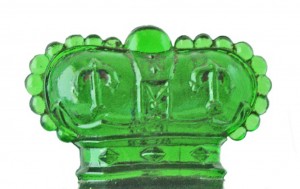The nineteenth century saw drastic changes in Salts, Scents and Society. Society’s two tiered class system developed layers with the addition of a moneyed middle class. Millions of men and women now earned wages — wages spent on necessities and frivolities. The single note scent was joined by blended bouquets. The use of synthetic chemicals was in its infancy in the late 1880s. Smelling salts became a fashion accessory for the home and office; in the purse and luggage; and around town on the top of a walking cane.
Perfume bottles also underwent drastic changes. Early in the nineteenth century, perfume was dispensed into an unadorned, unimaginative glass bottle to be decanted at home into a decorative bottle of one’s own choosing. Halfway through the century, when companies began pre-filling bottles with their perfumes, the bottles used were of plain, clear glass. Multiple perfumes used the same style of bottle. It was the paper label that gave the bottle its distinguishing identity – this bottle was Rose, that bottle was Violet. Not only was “company x” using the same bottle for its Rose and Violet perfumes, but “company y” was using a similar bottle for its Rose and Violet perfumes. For during this age of single note floral perfumes, every company had a White Rose, a Violet, a Lilac and a Ylang Ylang.
Commercial perfume bottles tended to look alike, whether displayed in the chemists shop, at the perfume bazaars of Paris or in the department stores of the large cities. There was a homogenous cluster of indistinct bottles, stoppers and fragrances.
The Crown Perfumery Company’s distinctive crown shaped stopper offered a brilliant contrast to competitors. The crown stopper was an ingenious addition, a unique way to capture a buyer’s attention amid a crowded field of non-descript bottles. The crown stopper had significance and power which no other perfume company could compete with, for what other company could use this regal symbol so boldly?
William Sparks Thomson would brand many of his bottles with an embossed “The Crown Perfumery Company London” as an additional method to distinguish his perfumes and salts from competitors. Branding his products also guaranteed that the purchaser would be rewarded with the superior quality and consistency associated with the firm. The embossing boldly stated that this product was real, not counterfeit. Throughout his life, Thomson would vigorously defend his products against all forms of counterfeiting.
Befitting their philosophy, Crown offered perfumes, bottles and packaging to fit the budget of every household. Their standard perfumes came in the standard bottle with a coordinating box. At their showrooms and at high end retail stores, more luxurious perfumes were offered in higher concentrations. These more expensive perfumes necessitated a better quality and style of bottle. They came in bottles of polished glass with hand cut faceted stoppers; bottles adorned with heavy silver overlay; and cut crystal bottles with silver ornamentation.
The standard bottle came in two sizes, 4” / 10.2 cm and 5” / 12.8 cm. Cardboard cases were made with designs that corresponded to the individual perfume it held.
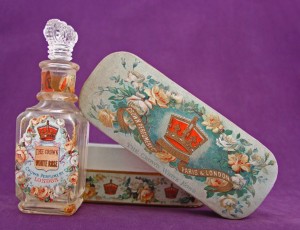
This standard bottle is 4″ / 10.2 cm tall.
La Belle Epoque era brought advances to perfume presentations. Graphics and ornamentation were beautifully designed in the Art Nouveau and burgeoning Art Deco style between 1879 and 1918.
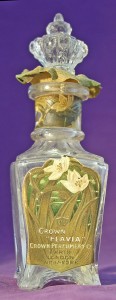
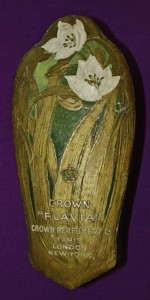
The bottle is 5″ / 12.8 cm tall
A very avant-garde crystal column was commissioned from Baccarat in 1910 for Parfum Adorable. Although the design was well in advance of the times, it did not stop Crown from placing Soupir d’Amour in this same abstract bottle in 1911. The crystal bottle had a crown, band and its name in gilt. In 1923, Rimmel would use a similar shaped Baccarat bottle for Ma Mie Annette.
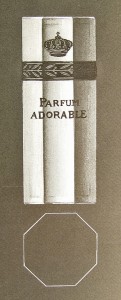
Baccarat, The Perfume Bottles
Courtesy Henri Addor
A completely different Baccarat design was created for an unknown fragrance in 1912. This smooth oval bottle with its low stopper was another unique style for Crown. Its smooth, classic shape would fit perfectly into a woman’s hand when she removed the stopper.
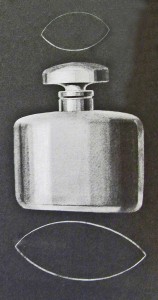
Baccarat, The Perfume Bottles
Courtesy Henri Addor
Eight decades would pass until another Baccarat crystal bottle held an exquisite Crown perfume.
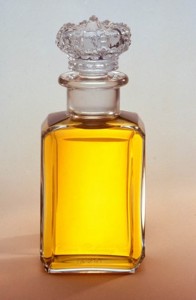
Marechale, 1994
Courtesy Barry H. Gibson
4.75″ / 12.1 cm
In 2005, Clive Christian Perfume unveiled No1 Imperial Majesty, an extraordinary Baccarat crystal bottle with a five carat white diamond and 18K gold collar filled with 500 ml of No1 pure perfume. There are only ten of these beauties in existence. At the U.K. Fragrance Foundation awards ceremony in 2006, No1 Imperial Majesty received the “Special Packaging” award. Clive Christian Perfume Co. is the only company to receive this award.
The 2006 Signed by Clive collection was a very Limited Edition set of Baccarat crystal spray bottles – ten bottles for each of the men and women’s eau de parfums. The No1 Eau de Parfum bottle embraced a white diamond; X, a black diamond; and 1872, an emerald.
Then as now, holidays were popular times to introduce gift sets of various combinations of perfume, powder, sachet and soap. These sets could be two bottles of perfume or perfume, powder and soap in an elegant satin lined case.
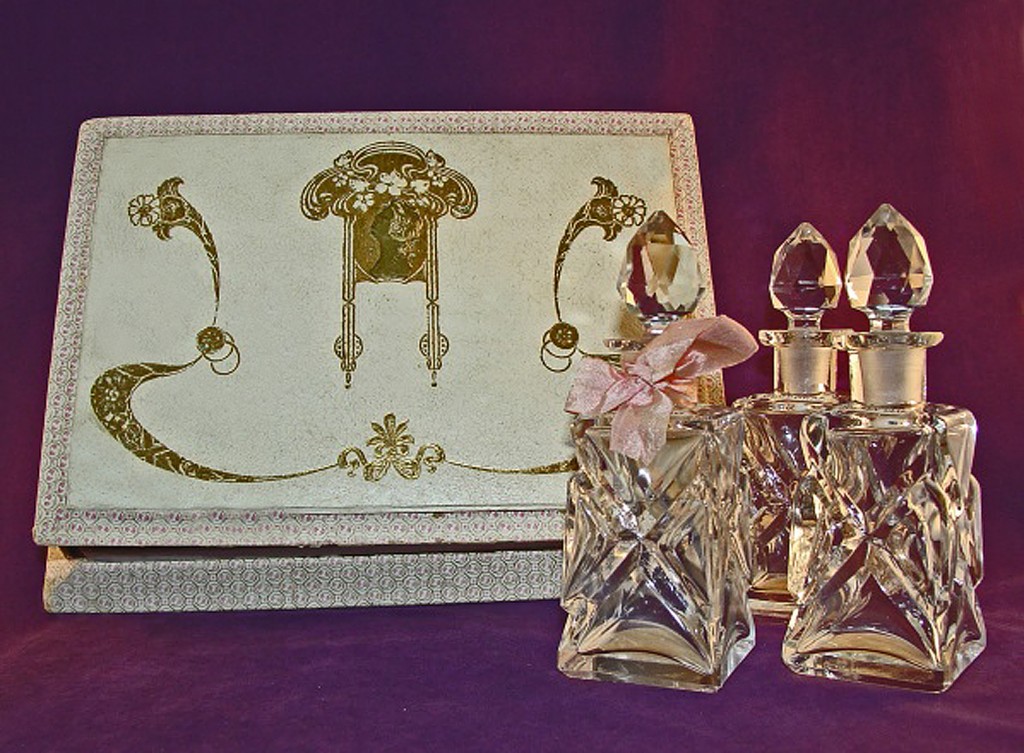
Gift set with three cut crystal bottles
.
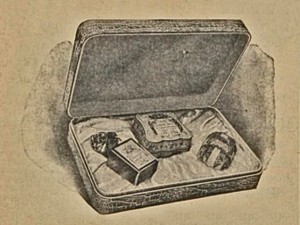
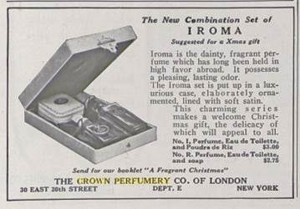
Jeunesse Dorée gift set, 1908 [20] Iroma gift set, 1912 [21]
The Christmas season brought forth novelty designs of wicker baskets resembling Christmas hampers made in Germany holding one, two or three bottles of Crab Apple Blossoms. Violettes de Parme came in a birch bark canoe.
Below, the silver gilt hinged cap covered a patented Crown sprinkler stopper on a cut crystal decagonal bottle. The bottle is 3 ½” tall with a cork lined sprinkler top. The design of the crown screw cap was registered with the British government in 1873. The date of the bottle and the perfume it held are unknown. It may have held Crown Lavender Water, Crown Eau de Cologne or any of the Crown perfumes. The screw cap with its regal crown was used on tubes of Crown toothpaste.
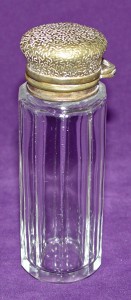
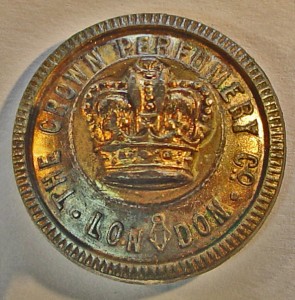
Perfume, Eau de Toilette, Crystal Distilled Eau de Cologne and Lavender Water had sprinkler tops.

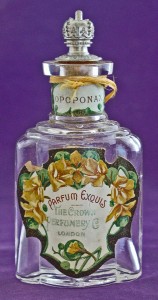
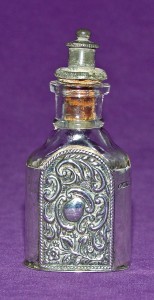
.
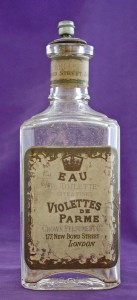
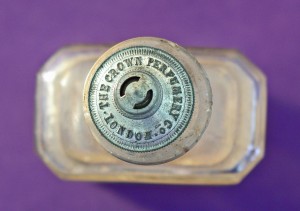
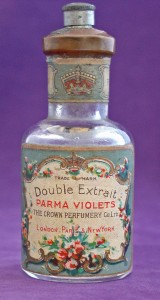
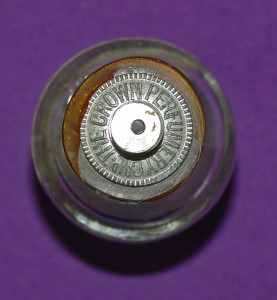
Known Bottle Manufacturers
1. Johnsen and Jorgensen Limited. London. 1901.
2. H.C. Fox & Sons. Philadelphia. 1901. Bottle manufacturer of stock bottles of 7-8 drams.
3. Baccarat. 1911, 1912, 1994, 2005, 2006
4. International Bottle Company. 4/17/1921. Appointed agents for the supply of bottles.
5. Robert Part and Co. Ltd. 1921. Appointed as import agents for bottles from Germany.
Distributors
Lehn & Fink became the importing and distribution agents for the United States in 1912. Lehn & Fink also distributed Crown Perfumery products in Argentina, Brazil, Paraguay, Peru and Uruguay.
In 1926, American distribution was given over to W.H. Schiefflelin & Co. Crown had a long relationship with Schieffelin, dating back to 1891 when Schieffelin sold Crown products as a wholesaler. In 1926, they became the sole agents for distribution. The contract was renewed in 1928 and lasted another twenty years.
Over in England, the export business was handled by United Exporters Ltd, part of the Lever group, from 1928 onwards. The Icilma Company Ltd. distributed Crown products in the UK and Ireland, from 1932 to 1941.
[20] Vogue. Vogue Online. 3 December 1908, 896.
[21] Vogue. Vogue Online. 1 December 1912, 120
